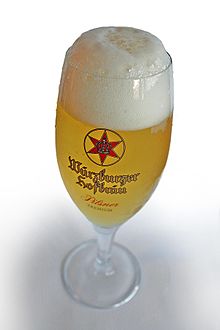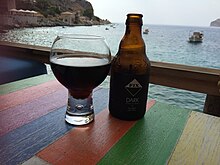Beer foam
Beer foam is foam on an open beer . The beer foam forms the froth or flower on the beer glass .
The foam arises from the gas bubbles rising to the surface of the drink. This gas, which is dissolved in the bottled beer, is formed as carbon dioxide during the brewing process or when bottling with additional gas that is forced on it. The resulting (permanent) head of foam consists of gas, protein , yeast and hop residues as lamellae between the gas bubbles. The carbon dioxide with which the bubbles in the foam are filled is created during fermentation and remains partially dissolved in the beer. The beer can be carbonated before or after it is filled into a bottle. Depending on the type, beer can continue to ferment in the bottle, and the beverage carbonizes with dissolved gas under the resulting overpressure. When the bottle is opened and poured into a glass, the pressure in the liquid drops to air pressure and dissolved gas bubbles up. Due to the ingredients mentioned, the gas foams on the surface of the liquid to form a foam head. In the case of pasteurized or filtered beer, the required gas pressure is carbonized manually in a subsequent process.
The density and longevity of the foam head are determined by the type of malt and its fermentation. The foam durability is technologically influenced by the different mashing processes and the origin of the grain. Wheat malt generally produces a finer and longer-lasting head than beer made from barley malt .
meaning
For the German consumer , the quality of the head of the beer is a quality parameter. This beer flower is usually the first impression for the consumer and it gives indications of the quality of the beer. Insufficient head can be an indication that the beer is stale and not freshly tapped. A long-lasting and stable head of foam has a technological meaning in addition to the sensory one . The foam prevents the CO 2 from escaping too quickly from the beer, which ensures the perceived freshness.
Chemical composition
The carbon dioxide dissolved in the beer is crucial for the head of foam. In order to ensure good beer foam stability, foam-promoting substances are required. High molecular proteins, especially glycoproteins , which are good foaming agents , form a basis . The molecular size of the proteins and their degree of substitution, i.e. the number and length of the carbohydrate chains of these glycoproteins, are decisive . These proteins remain in the brewing process or are added from the outside during this. The fraction of MgSO 4 -preciable nitrogen correlates well with the foam durability . Another foam-forming substance are isomerized bitter substances, the proportion of which increases the amount of surface-active substances in beer. Melanoidins have a positive effect on the surface tension of the beer.
Detergents such as cleaning agents and disinfectants that remain in the beer glass as detergent residues, however, are detrimental to foam formation . This lowers the surface tension of a liquid or the interfacial tension between two phases (beer and air). Fats or fatty acids above a certain threshold value have a preventive effect on a “beautiful beer flower” .
Role of the gases dissolved in beer
Carbon dioxide is produced naturally through alcoholic fermentation , during which the yeast converts the sugar dissolved in the wort into ethanol and carbon dioxide. Additionally - or alternatively - can by means of a CO 2 - pressurized gas bottle are beer or similar device under a certain pressure and at a suitable temperature enriched with carbon dioxide. In the finished beer, the carbon dioxide remains bound as carbonic acid and is released again when the bottle is opened due to the loss of excess pressure .
The creamy head of special beers such as Guinness is formed by adding nitrogen or replacing carbon dioxide with nitrogen and is only partly based on the carbon dioxide, which is the only driving force in conventional beers. These substances can either be bound immediately by overpressure when bottles and cans are being filled or, in the case of kegs, when tapped afterwards. The use of nitrogen in beer creates a persistent head of foam with small bubbles and also ensures that the usually overly acidic taste of carbon dioxide is reduced.
Physical examination
In January 2002 Arnd Leike published a paper on the decay of beer foam. In this he was able to prove that it is an exponential decay and that the decay constant is different for different types of beer. This measure can be used as a sign of the quality of a beer. For this realization he was awarded the Ig Nobel Prize that same year .
Importance of the glass

Beer glasses are often designed in such a way that they emphasize or highlight the head of foam. There are many other properties that influence the head of foam in a beer glass, such as a roughened bottom in the glass. This is comparable to the mousse point in champagne glasses, where a point on the bottom of the champagne glass is deliberately roughened to facilitate the development of bubbles. The roughened bottom of beer glasses is used to facilitate the formation of carbon dioxide bubbles at the bottom of the beverage. This prevents the majority of the bubbles from forming and being released on the surface, which leads to a faster dissolving of the foam head.
In addition, skin fats or oils from consumers, aerosol particles from cooking fats or traces of edible fats can accumulate on the glass surfaces. These fats lead to a significant reduction in the head of the foam in beer, "the flower collapses". Fats prevent the formation of new foam bubbles, which means that the foam head is more short-lived. In addition, the collapsing foam sticks to the edge of the glass and no longer runs down the side, which leads to an even faster foam reduction when drinking.
Thoroughly drying the beer glass after washing is another aspect. The water in the glass can settle on the bottom and thus cover the roughened areas. This means that no more bubbles can form here. The uncontrolled formation of bubbles within the drink consequently causes faster evaporation . Nevertheless, dry glasses are not preferred for every type of beer, for example wet glasses are often used in Belgian Witbier to slow down superfluous foam. As mentioned, detergent left in the glass can also “break the flower”.
Others
The over-foamed or the coated beer foam in draft beer is called lick beer , which is caught in tap systems and often also when tapping beer from kegs in a tub under the tap that is usually covered with a perforated, grated or slotted plate . Earlier the leak beer was often at a lower price to financially underprivileged customers served . Today the term is also used for stale, thin, stale or adulterated beer as well as for an inferior type of beer .
Web links
- Richard Kingsley: There is plenty of physics involved in opening a bottle of beer . madsci.org; accessed June 15, 2015
- Vivienne Baillie Gerritsen: One beer please . expasy.org; accessed June 15, 2015.
- Cheers Physics! physics.org; accessed June 15, 2015.
- What does the foam reveal about beer? (FAZ April 13, 2018)
Individual evidence
- ^ S. Jackson: Factors affecting beer foam . In: Journal of the Institute of Brewing , Volume 59, Issue 4, April 10, 2013, pp. 317–322.
- ↑ a b c Ted Goldammer: The Brewer's Handbook: A Complete Book to Brewing Beer. Apex Publishers, 2008, ISBN 978-0-9675212-3-7
- ↑ a b c Marco Potreck: Optimized measurement of the beer foam stability as a function of environmental conditions and fluid dynamic parameters . Technical University of Berlin, February 12, 2004.
- ↑ BeerSci: How To Make Beer Foamier . Popular Science; accessed on June 13, 2015
- ↑ Youxue Zhang, Zhengjiu Xu: “Fizzics” of Bubble Growth in Beer and Champagne. In: Elements , February 2008, Volume 4, Number 1, pp. 47–49.
- ^ Arnd Leike: Demonstration of the Exponential Decay Law Using Beer Froth . (PDF) In: European Journal of Physics. Volume 23, January 2002, pp. 21-26.
- ↑ Martine Stead, Kathryn Angus, Laura Macdonald, Linda Bauld: Looking into the Glass: Glassware as an Alcohol Marketing Tool, and the Implications for Policy , May 1, 2014, Volume 49, Issue 3.
- ↑ Glass To Last . Hospitalitymagazine.com.au. February 18, 2010. Archived from the original on March 8, 2012. Retrieved on February 24, 2010.
- ^ J. Murphy: The Principles and Practices of Bar and Beverage Management - The Drinks Handbook. Goodfellows Publishing, Oxford England 2013.
- ↑ Nick Eggers: Do you speak Hamburgisch? (395). In: Abendblatt.de . April 17, 2010, accessed September 26, 2016 .


